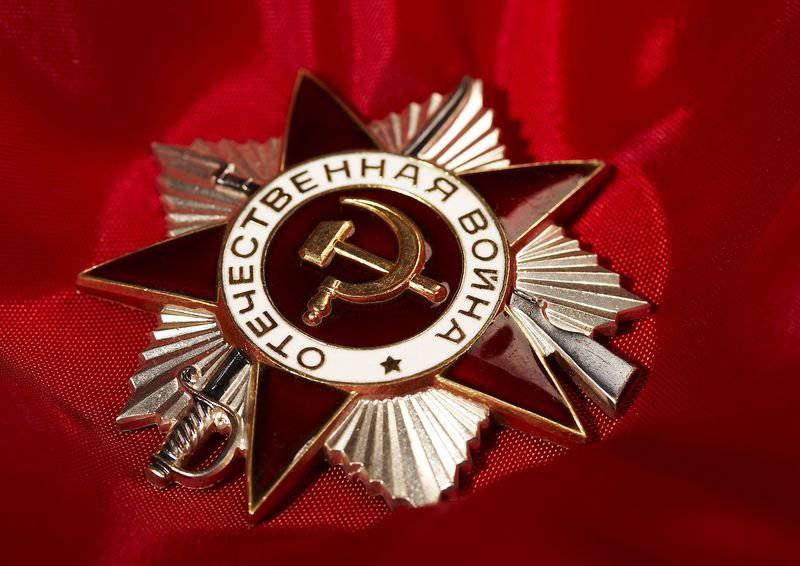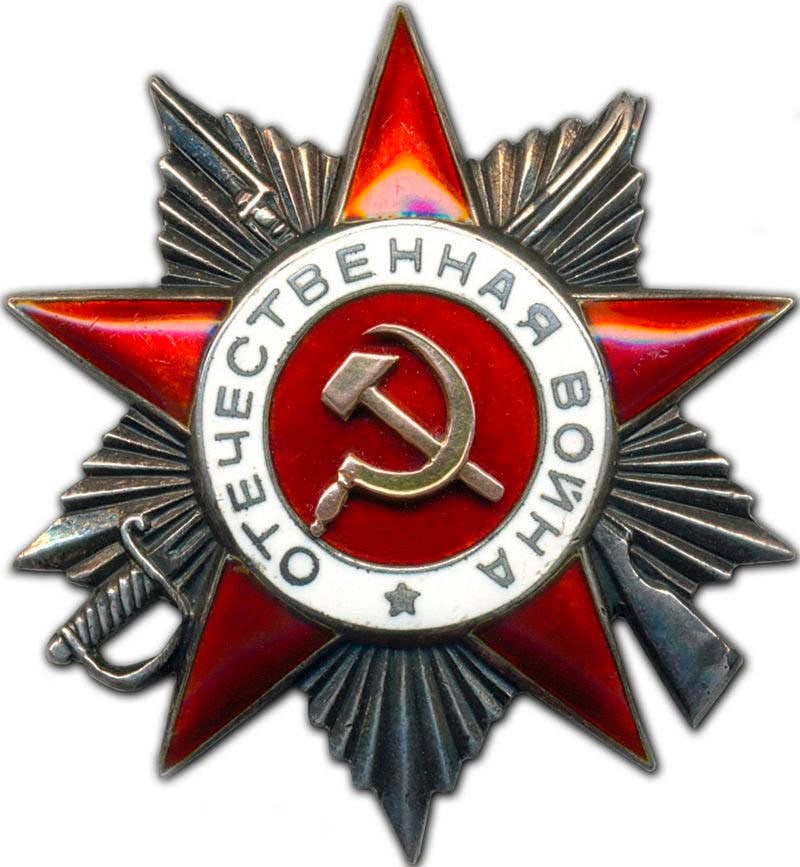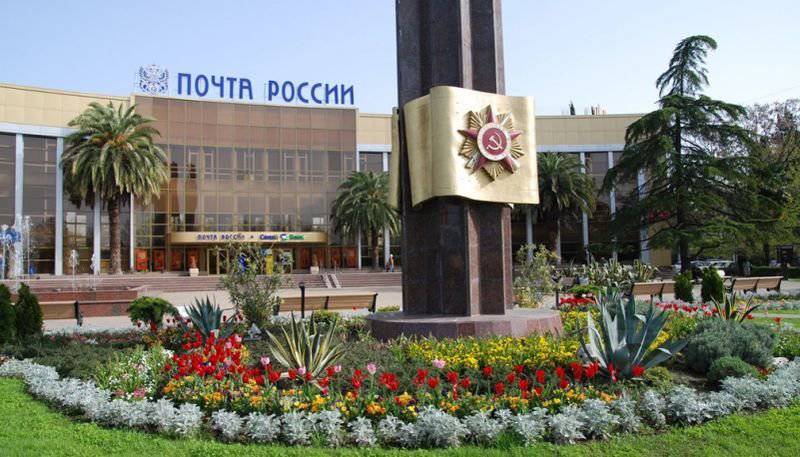Military orders and medals of the Soviet Union. Order of the Patriotic War
10 April 1942, Joseph Stalin ordered Colonel General A. V. Khrulev, who served as the head of the rear services for the Red Army, to order the development of a new military order. Initially, the award was to be called “For Military Valor,” but then the name was changed. Already on April 10, the artist A.I. Kuznetsov, who was a recognized expert in creating various military insignia, was given the task of developing a sketch for a future award. The new order was supposed to reflect the idea of a nationwide struggle against the invaders. As materials for the new award was planned to use gold, silver and copper.
A similar task was given to another Soviet artist S.S. Dmitriev, who was one of the authors of the Order of Lenin, the medals "For Courage", "For Military Merit" and "XX Years of the Red Army". In just two days, both artists sketched out an order of 30 sketches of a future award. A. V. Khrulev presented all the prepared sketches to Stalin, who selected two works by A. Kuznetsov and S. Dmitriev, but in the end still accepted the sketch by A. Kuznetsov, making minor changes to the appearance of the award. It was decided to give the name “Patriotic War” to the new Soviet order. First time in stories The award system of the USSR had to have two degrees: 1 and 2.

In May 1942, a new order was established, the highest degree of the order being the first. The statute of the order provided for the awarding of servicemen of all military branches, including commanders and fighters of partisan formations. New orders specified the military feat of soldiers and officers of the Red Army. For example, the Order of the Patriotic War of the 1st degree was issued for the fulfillment of any of the 30 points of the statute, which were also called combat situations. The Order of the Patriotic War of the 2nd degree was issued for the performance of 25 similar tasks. The main difference between them was digital. For example, the Order of the Patriotic War of the 1st degree was awarded for the destruction of artillery fire at least 3 enemy aircraft (for the 2nd degree, two aircraft were enough); who, being in the crew tank, destroyed at least 4 enemy tanks (for the 2nd degree - three tanks), who committed, being part of the assault crew aviation, 25 successful sorties (for the 2nd degree - 20 sorties), etc.
The Order of the Patriotic War was the first award that appeared during the Second World War, as well as the first order in the USSR, which had a division into degrees. In addition, for 35 years, this order was the only military award that was given to the family as a memory after the death of the person awarded with it (all other Soviet orders needed to be returned to the state). Only in 1977, the order of leaving orders and medals in the family was revised, and they were allowed to leave as a relic.
The badge of the Order of the Patriotic War was a convex five-pointed star, the rays of this star were covered with ruby-red enamel. This star superimposed on a golden star with rays. In the center of the award there was a ruby-red circle, in which there were a hammer and sickle, bordered by a white enamel belt. The inscription “Patriotic War” was made on the belt, in the lower part of the belt there was a small golden star. Because of the five-pointed ruby-red star, parts of crossed sticks and rifles protruded. The Order of the Patriotic War of the I degree was different from the Order of the II degree in that the Order of the Patriotic War of the II degree had a red star superimposed not on a gold but on a silver star. The lower radiant star was polished, the images of the checkers and rifles were oxidized. All other parts of the award, which were not enamelled, were gilded.

Order of the Patriotic War, I degree produced from gold (585 samples) and silver. The order contained 8,329 ± 0,379 g of gold and 16,754 ± 0,977 g of silver, the total mass of the award was 32,34 ± 1,65, the Order of the Patriotic War of the II degree was made of silver. Gold contained 0,325 g, silver - 24,85 ± 1,352 g, the total weight of the award was 28,05 ± 1,50 g. The overhead sickle and hammer located in the center of the order were made of gold on both degrees of the award. The diameter of the circle (the size of the Order of the Patriotic War between the ends of the gold or silver and red stars) was 45 mm. The length of the checkers and rifles was also 45 mm. The diameter of the central circle with the inscription was 22 mm.
The first cavaliers of the new military award were Soviet artillerymen. By decree of the Presidium of the Armed Forces of the USSR from 02.06.1942 of the year to the Order of the Patriotic War I degree were presented Captain I. I. Krikliy, I.K. Junior Political Officer, A.K. commanded by Captain Krikliy, for 1942 of the day of fighting in the Kharkiv region, managed to destroy the enemy’s 2 tank. Senior Sergeant Smirnov A.V., after all the other numbers for his calculation had died, he continued firing from the gun. He continued to fight even after a fragment of a projectile exploded nearby tore off his hand. Overcoming physical pain, Smirnov continued to shoot, using only one hand. In this battle, he managed to destroy 32 German tanks. The commissar of the division, junior political commander Statsenko IK, during the battle, not only supervised subordinates, but also inspiring the soldiers by personal example, he himself managed to destroy several German tanks. The commander of the artillery battalion, captain Krikliy personally knocked out German tanks 6, but in the battle was seriously wounded and later died in the hospital.
In total, during the years of the Great Patriotic War, about 350 thousands of awards were made with the Order of the Patriotic War of I degree and about 926 thousands - II degrees. At the same time, it is worth noting that this order began to be issued only in 1942 year. At that time Leningrad was under German blockade, and most of the workers of the mint worked in the evacuation. So even the order had to be produced in difficult conditions of wartime.

Hero of the Soviet Union I.Ye. Fedorov (1914-2011) Knight of the Five Orders of the Patriotic War
In Soviet history, there are cases of awards when the Order of the Patriotic War received whole military units, units, defense enterprises, military schools and even entire cities. In addition, a large number of foreigners were presented for the award. This order was mainly awarded to soldiers and officers of the Czechoslovak Corps, the Polish Army, as well as French pilots from the Normandie-Neman fighter air regiment, and it was received by British sailors participating in the famous polar convoys. One American was among those awarded with the Order of the Patriotic War, Averell Harriman, who served as US Ambassador to Moscow from 1943 to 1946.
A large number of officers and soldiers of the Red Army were awarded this order twice, someone became a knight of three and even four orders of the Patriotic War. For example, Sergeant Yanenko N. A., a tank driver, immediately became the owner of the 4-x orders of the Patriotic War (two orders of the 1 and 2-degrees). Among those who were awarded three orders of the I degree were the Heroes of the Soviet Union, Major I. Bespalov, and Colonel Goryachkin, TS, Major General of the Tank Forces, Zhilin, A. N.
The greatest number of awards for such an honorary award during the war years and for postwar differences was noted by Fedorov Ivan Evgrafovich - at once 5 orders (4 of World War I degree and 1 Order of Patriotic War II degree). In addition, in 1948, Fedorov became the Hero of the Soviet Union. Ivan Evgrafov graduated from the Great Patriotic War with the rank of colonel, he served as commander of the 273-th Gomel Fighter Division (he fought on the Leningrad front). After the end of the war, Fedorov I. Ye. Worked for some time as a test pilot in the well-known OKB Lavochkin.

Stella in honor of awarding Sochi with the Order of the Patriotic War, I degree
In 1947, the Order of the Patriotic War was officially stopped. However, there were cases when the Order was periodically issued again. For example, in 1960-ies they were awarded residents of foreign countries who provided assistance to Soviet prisoners of war, and many citizens from among former Soviet prisoners of war, underground fighters and partisans were also awarded. In 1985, the Order of the Patriotic War was revived again, this time in the form of a memorable award for WWII veterans, on the occasion of the 40 anniversary of victory in the war. The design of the 1985 awards of the year was significantly different from the “military” orders, and the gold in them was replaced with ordinary gold plating. In total, the 1991 2 398 Order of the Patriotic War of the I degree and the 322 6 688 of the Order of the Patriotic War of the II degree were awarded to the 497 in the USSR.
Information sources:
http://ordenrf.ru/su/orden-otechestvennoy-voyny.php
http://milday.ru/ussr/ussr-uniform-award/94-orden-otechestvennoy-voyny.html
http://medalww.ru/nagrady-sssr/ordena-sssr/orden-otechestvennoj-vojny/
http://www.rusorden.ru/?nr=su&nt=o11
Information